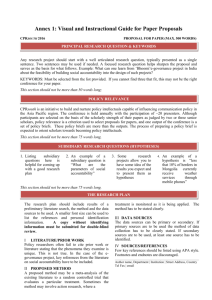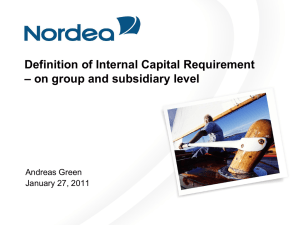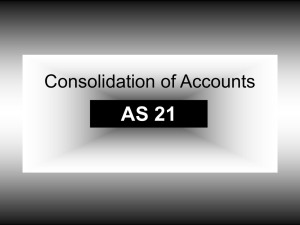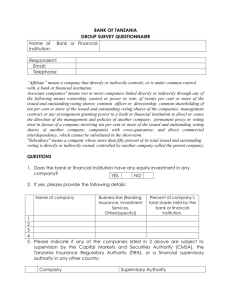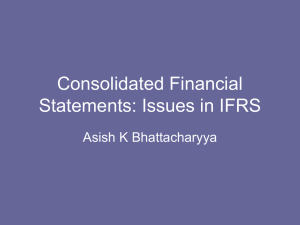The Case of Economic Oneness of Group Companies
advertisement
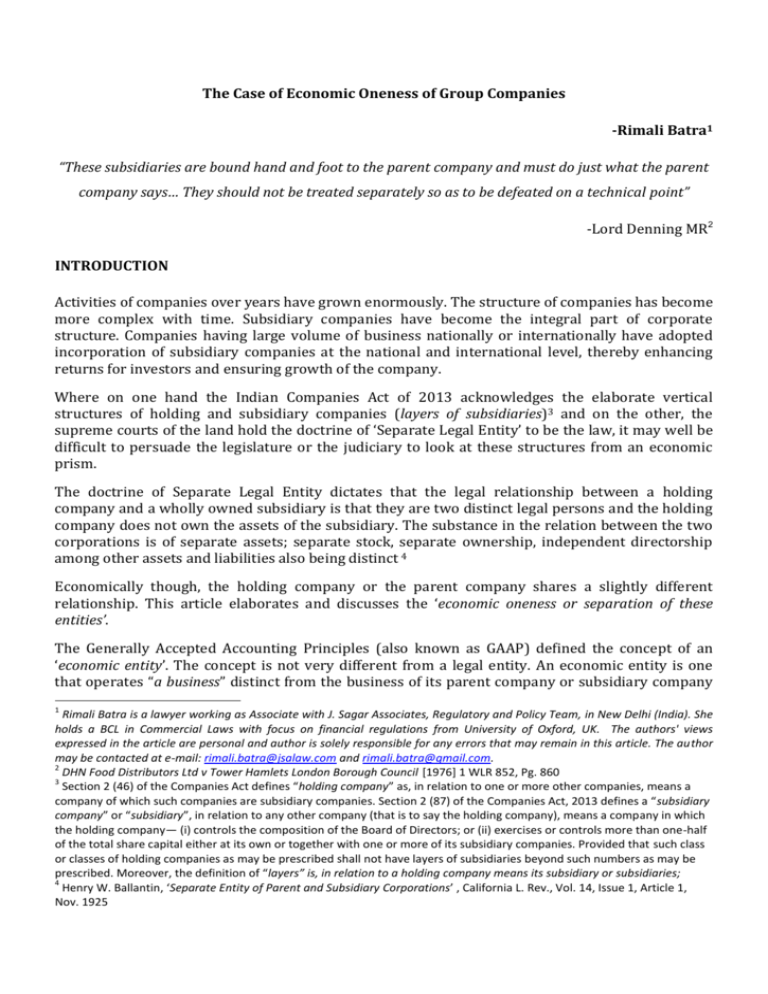
The Case of Economic Oneness of Group Companies -Rimali Batra1 “These subsidiaries are bound hand and foot to the parent company and must do just what the parent company says… They should not be treated separately so as to be defeated on a technical point” -Lord Denning MR2 INTRODUCTION Activities of companies over years have grown enormously. The structure of companies has become more complex with time. Subsidiary companies have become the integral part of corporate structure. Companies having large volume of business nationally or internationally have adopted incorporation of subsidiary companies at the national and international level, thereby enhancing returns for investors and ensuring growth of the company. Where on one hand the Indian Companies Act of 2013 acknowledges the elaborate vertical structures of holding and subsidiary companies (layers of subsidiaries)3 and on the other, the supreme courts of the land hold the doctrine of ‘Separate Legal Entity’ to be the law, it may well be difficult to persuade the legislature or the judiciary to look at these structures from an economic prism. The doctrine of Separate Legal Entity dictates that the legal relationship between a holding company and a wholly owned subsidiary is that they are two distinct legal persons and the holding company does not own the assets of the subsidiary. The substance in the relation between the two corporations is of separate assets; separate stock, separate ownership, independent directorship among other assets and liabilities also being distinct 4 Economically though, the holding company or the parent company shares a slightly different relationship. This article elaborates and discusses the ‘economic oneness or separation of these entities’. The Generally Accepted Accounting Principles (also known as GAAP) defined the concept of an ‘economic entity’. The concept is not very different from a legal entity. An economic entity is one that operates “a business” distinct from the business of its parent company or subsidiary company 1 Rimali Batra is a lawyer working as Associate with J. Sagar Associates, Regulatory and Policy Team, in New Delhi (India). She holds a BCL in Commercial Laws with focus on financial regulations from University of Oxford, UK. The authors' views expressed in the article are personal and author is solely responsible for any errors that may remain in this article. The author may be contacted at e-mail: rimali.batra@jsalaw.com and rimali.batra@gmail.com. 2 DHN Food Distributors Ltd v Tower Hamlets London Borough Council [1976] 1 WLR 852, Pg. 860 3 Section 2 (46) of the Companies Act defines “holding company” as, in relation to one or more other companies, means a company of which such companies are subsidiary companies. Section 2 (87) of the Companies Act, 2013 defines a “subsidiary company” or “subsidiary”, in relation to any other company (that is to say the holding company), means a company in which the holding company— (i) controls the composition of the Board of Directors; or (ii) exercises or controls more than one-half of the total share capital either at its own or together with one or more of its subsidiary companies. Provided that such class or classes of holding companies as may be prescribed shall not have layers of subsidiaries beyond such numbers as may be prescribed. Moreover, the definition of “layers” is, in relation to a holding company means its subsidiary or subsidiaries; 4 Henry W. Ballantin, ‘Separate Entity of Parent and Subsidiary Corporations’ , California L. Rev., Vol. 14, Issue 1, Article 1, Nov. 1925 or other group companies, as the case may be5. It is like legal separation because like separate legal entity demands that the management of the business of the subsidiary vests in its own Board of Directors and not with the Board of Directors of its holding company, economic separation demands that the business of the subsidiary is distinct from the business of the parent company. The problem is that the economic distinctness is not absolute in practice and this makes for a slippery slope to conclude that there is no business and management influence of the parent company on its subsidiary company. There are instances when the economic distinction blurs thereby making the assessment of legal separation difficult. The paper henceforth evaluates such instances. ECONOMIC ONENESS (OR DISTINCTION) Master of the trade A ginormous number of economic activities are controlled by just 10 multinationals, as below:- Looking closely at this chart graphic presentation prepared by Convergence Alimentaire, one may infer that many an independent activities are carried out under the business influence and strategies of one name. However distinct is the business or the brand there is a possibility strong influence of the parent company. In other words, it may be very difficult to state with clarity where the assets of the parent end and the assets of the subsidiary begin. There is also the risk of sharing and borrowing of investments of one company for building the business of the other company, inter-corporate loans, thereby making a company the debtor of the other company. What is interesting is that the loss of one will be the loss of the other in such a case, thereby making the distinctness of separate entities in legal terms, not absolute. 5 As per GAAP: A group is a parent and all its subsidiaries The actual position in India is that the holding company controls a number of subsidiaries and respective businesses of companies within the group and manages and integrates as whole as though they are merely departments of one large undertaking owned by the holding company. Holding companies and their subsidiaries can create pyramids or even layers, whereby a subsidiary owns a controlling interest in another company and becomes its parent company. A deemed subsidiary under Section 4(3) of the Act of 1956 is a company that among other requirements, is holding share capital in excess of 50% as controlling power in the composition of Board of Directors of the holding company. In other words, a holding company is one which owns sufficient shares in the subsidiary company to determine who shall be its directors and how its affairs shall be conducted. A holding company, of course, if the subsidiary is a wholly owned subsidiary, may appoint or remove any director if it so desires by a resolution in the General Board Meeting of the subsidiary. Insolvency of Group Companies Groups of companies are common structure throughout India. However, there is no provision in any of laws to deal with the insolvency of group companies, for the reason that a subsidiary is considered distinct from its parent company6. A problem may arise when the economic interest of the group gets into financial difficulty and the courts need to find a solution that is viable for the parent, keeping the assets of the subsidiaries and the group collectively away from that of the parent. The solution to such a problem has been engraved in the doctrines of separate legal entity and lifting the corporate veil which collectively make it impossible for the courts to make a purely economic inquiry in the structure of the parent and the subsidiary company. But, if the court was to make a purely economic enquiry, it would not be difficult to state that these entities are economically one for the simple reason that business distinction cannot be as clearly drawn as the distinct in incorporation of these entities. In the EU, the group companies are taken up collectively and severally for insolvency to avoid jurisdiction complexities, especially where a parent has subsidiaries all across the globe. In India though, the insolvency proceedings is an independent affair and we have a long way to go before collective proceedings can be a reality. The subsidiary is an asset of the Parent Company The subsidiary company is an asset for its holding or parent company. A 100% wholly owned subsidiary may at times be a mere business presence of the parent company. In numerous cases, majority of which arise out of revenue claims of the government against the subsidiary company, the courts have felt immense compulsion to stick to the legal norm of separate legal entity, even in when the balance sheets, profit and loss accounts, and the economic and business relationship narrates a contrary position. In the UK, the business distinction between a subsidiary company and a holding company is clear, such that the business of a subsidiary is not the business of the holding company.7 Courts, however, will not allow the separate corporate entities to be used as a means to carry out fraud or to evade tax. Multi-National Companies, by setting up complex vertical pyramid like structures, would be able to distance themselves and separate the parent from operating companies, thereby protecting the multi-national companies from legal liabilities of tax. The Supreme Court in the case of Vodafone International Holdings B.V. v. Union of India (UOI) and Anr.8 observed defined control that a parent has on its subsidiary, as follows:- 6 See Renusagar Power Co. Ltd vs General Electric Co 1994 AIR 860; See also Vodafone International Holdings B.V. v. Union of India (UOI) and Anr, [2012] 6 SCC 613 7 Gramophone and Typewriter Ltd. v. Stanley (1908)1 0 All ER Rep 833: Pg 837 8 [2012] 6 SCC 613 “166. Control, in our view, is an interest arising from holding a particular number of shares and the same cannot be separately acquired or transferred. Each share represents a vote in the management of the company and such a vote can be utilized to control the company. Controlling interest, therefore, is not an identifiable or distinct capital asset independent of holding of shares and the nature of the transaction has to be ascertained from the contract and the surrounding circumstances. Controlling interest is inherently contractual right and not property right and cannot be considered as transfer of property and hence a capital asset unless the Statute stipulates otherwise. Acquisition of shares may carry the acquisition of controlling interest, which is purely a commercial concept and tax is levied on the transaction, not on its effect.” In the case of Merchandise Transport Ltd. v. British Transport Commission 9 , Shaw L.J. observed the legal distinctness in assets and businesses of group companies as follows: “… that there was so complete an identity of the different companies comprised in the socalled group that they ought to be regard for this purpose as a single entity. The completeness of that identity manifested itself in various ways. The directors of Company A (parent company) were the same as the directors of Company B (subsidiary company); the shareholders of Company B were the same as in Company A, the parent company, and they had a common interest in maintaining on the property concerned the business of the group. If anything were necessary to reinforce the complete identity of commercial interest and personality is … Company A undertook the obligation to procure their subsidiary company to make the payment which the bank required to be made by Company A. If each member of the group is regarded as a company in isolation, nobody at all could have claimed compensation in a case which plainly calls for it. Company B would have had the land but no business to disturb; Company A would have had the business to distribute but no interest in the land.” In India though, as per the Indian Accounting Standard 2710 the parent company is mandated to prepare a consolidated statement of accounts for its subsidiaries along with a separate financial statement for its entity. The consolidated financial statements are defined as the financial statements of a group presented as those of a single economic entity.11 This means that a subsidiary is not completely distinct in its assessment of assets and liabilities and so is not the parent. Where the business assets of a subsidiary are reflected as the assets of the Parent/Group Company, it may well be difficult to draw a clear line of distinction. Realm of Competition Law and Anti-Competitive Practices by Group Companies For the sake of Competition and avoiding anti-competitive practices the principle of the personal responsibility of the economic entity which has committed the infringement is excused. If the parent company is part of that economic unit, which may consist of several legal persons, the parent company is regarded as jointly and severally liable with the other legal persons making up that unit for infringements of competition law in European Countries. Even if the parent company does not participate directly in the infringement, it exercises, in such a case, a decisive influence over the subsidiaries which have participated in it. 9 [1962] 2 QB 173: Pg. 473 GAAP Principles, Indian Accounting Standard 27 11 GAAP Principles, Part 4: Definitions in Indian Accounting Standard 27 10 As of today, the Indian Competition Law still holds economic separation very close to its heart. The Competition Commission of India explained the converse, as applicable in India today, in the case of Arshiya Rail Infrastructure Limited v. Ministry of Railways and Container Corporation of India Limited12 in the following words: “…only that part of the activity of the enterprise is to be taken into consideration which is related to the relevant market…. Arshiya is a multinational company active in various markets and constituted a subsidiary in India for the purpose of container trains…It is natural that economic strength of other group companies active in diverse markets, but having no share in the relevant market cannot be considered as part of economic strength of subsidiary company for the purpose of determining dominance in a particular relevant market. If subsidiary of a company is active in a particular relevant market, the strength of holding company active in different markets cannot be clubbed with the subsidiary company to determine dominance in the relevant market…” Being an economic law, it may be important that the competition law regulators view group companies from the prism of economic oneness for identifying dominance, if not the abuse of dominance. The Parent Company gets penalised for acts of the Subsidiary Company For a lot of times the courts have made the parent company owe up the penalty imposed on its subsidiary company for the simple reason that the subsidiary company may not have been in a position to carry the financial burden of the penalty. This is exemplary to show that there is oneness in the assets of these group companies and the court may not hesitate to hold them as one entity in case where there is a breach of duty or harm caused to the economy, investors or stakeholders of the group company. There is an underpinning cross-trigger wherein the parent company’s assets are staked for the penalties imposed on its subsidiary company. The U.S. Supreme Court in United States v. Bestfoods13 explained that it is a general principle of corporate law and legal systems that a parent corporation is not liable for the acts of its subsidiary, but the Court went on to explain that corporate veil can be pierced and the parent company can be held liable for the conduct of its subsidiary, if the corporal form is misused to accomplish certain wrongful purposes, when the parent company is directly a participant in the wrong complained of. Mere ownership, parental control, management etc. of a subsidiary is not sufficient to pierce the status of their relationship and, to hold parent company liable. WHY ARE WE MISSING THE ECONOMIC PRESPECTIVE Though the Ind AS 27 does not deal with the method of consolidation and their effect on consolidation, but the inference of the fact that the entities share, sink and sail on common assets and liabilities is not too difficult. This then raises a question on the presumed economic separation of parent and subsidiary companies. The control over an economic entity is envisaged in Ind AS 27 as the power to govern the financial and operating policies of an entity so as to obtain benefits from its activities. 14 The economic entity principle states that the recorded activities of a business entity will be kept separate from the recorded activities of its owner(s) and any other business entities. This means that you must maintain separate accounting records and bank accounts for each entity, 12 [2013] 112 CLA 297 524 US 51 (1998) 14 Supra Note 3 13 and not intermix with them the assets and liabilities of its owners or business partners. Also, you must associate every business transaction with an entity. Considering the above instances, it may be safe to state that the companies may be same economic entities for economic purposes and may be separate legal entities for purposes of law. Professor Gower in his book on company law has stated that there is evidence of a general tendency to ignore the separate legal entities of various companies within a group, and to look instead at the economic entity of the whole group.15 In cases where the Holding and Subsidiary company identify and record similar assets and liabilities, it becomes tedious to bifurcate with certainty where the assets of one begins and where the liability of the other ends. The test to identify this is not simple. The mere fact that the parent corporation owns all the stock of the subordinate corporation, or that the same individual owns all the stock in both corporations, does not make them the same concerns in law but in economics, the business is being generated out of the same assets and therefore there is a possibility of oneness. Also, in cases where the stock of ownership is resorted to not for the purpose of participating in the affairs of the corporation in the customary and usual manner, but for the purpose of controlling the subsidiary company so that it may be used as an instrumentality of the owning company, the court will not permit itself to be blinded by the mere corporation form, but will in proper case, disregard the corporate entity and treat the two corporations as one16. CONCLUSION The primary object of organisation of corporations and value of corporate privilege depends on the separation of capacities, and on the fact that although the corporation acts for its stakeholders, their stakeholders are not personally liable for its acts. 17 It is nevertheless true that is the separate corporate capacity is perverted to dishonest uses to evade obligations or to defeat public welfare; the courts will penetrate the device, uncover the abuse of the special privilege and circumvent fraud.18 Hence, even by being distinct on paper, the companies were economically one unit and legally, if a fraud or sham or violation of statutory obligation is found, then on one legal entity. In numerous cases it is contended that a subsidiary corporation is so far owned and controlled by another as to make the parent corporation responsible for the acts and obligations of the subsidiary. Unfortunately it does not seem to be possible to lay down any definite test as to when the usual immunity of the stockholder should be regarded, but the courts assign various grounds which to a great extent are vague and illusory. 19 Therefore, though the doctrine or Separate Legal Entity and Lifting the Corporate Veil is well founded, there is lack of clarity on economic oneness of these entities and whether such economic oneness makes for a valid ground or not for the courts to exercise discretion for lifting the veil, is still a ground not envisaged. ***** 15 Gower & Davies, ‘PRINCIPLES OF MODERN COMPANY LAW’, 9th Edition, Chapter 1, Sweet and Maxwell: 2012 McWilliams, Limitations in the Theory of Corporate Entity in California, 4 California Law Review, 465 17 Salomon v. Salomon & Co. [1897] App. Cas. 22, 43 18 Canfield, ‘Scope of Corporate Entity Theory’, 17 Columbia Law Review, 128; 19 Supra Note 2 16


